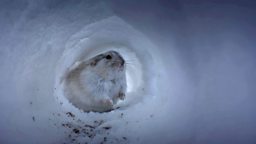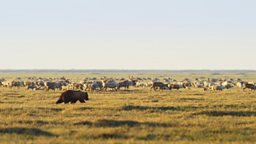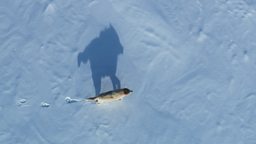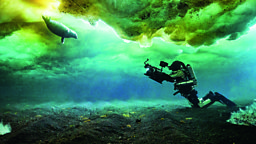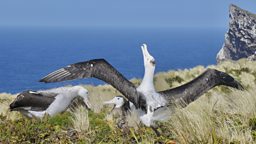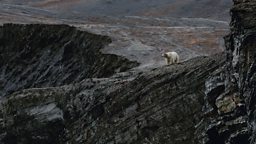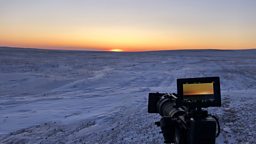Pallas’s cats on the Mongolian Steppe
By Sarah Titcombe, assistant producer for Frozen Planet II

An impossible task?
During our research for this sequence, we had been told we shouldn’t even bother trying to film the Pallas’s cat in winter. Filming such an animal that, in winter has no fidelity to one burrow site, would be near impossible. We wouldn’t be able to find such a small animal in the vast grassland Steppe of Mongolia, and on top of this, they have extremely nervous dispositions.
Thousand of miles of undulating steppe, nervous cats and extreme cold
But on Frozen Planet II we wanted to bring viewers to other surprising frozen worlds outside of the Poles. Seeing the ‘grumpiest cat in the world’ in winter, which until recently has been a little-known animal, would be a first for our viewers and was something we wanted to deliver.
There was one particular person that gave us some hope! We teamed up with the researcher and photographer, Otgonbayar Bataargal, who works with this wife Buyanaa in an area with a healthy population of cats. We were buoyed by the idea, yet during our planning, everything was telling us it was still going to be very hard. Thousand of miles of undulating steppe, nervous cats and extreme cold was sure to make for an interesting ride.
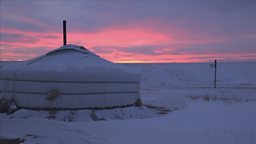
Surprise early appearance
Arriving in Mongolia, I was struck by its vastness. The beautiful nothing. Miles and miles of rolling grassland, punctuated only occasionally by a nomad’s ger and some livestock in the far distance.
they really hate walking in deep snow!
To our surprise, our first day brought us a tantalising glimpse. Oogie took us to the top of a hill on the steppe. Through his scope, more than a kilometre away in an unassuming pile of rocks - the only ones for miles around - I could see a tiny blob, a Pallas’s cat! We were so excited!
We had been blessed with a recent and healthy dump of snow with eye wateringly low daytime temperatures, sometimes close to -30°C in the mornings. This was exactly what we needed. Pallas’s cats, have the densest coat of any cat, but even they must conserve energy as much as they can. Movement between burrow sites when it’s that cold is minimal, and the idea of hunting at night where temperatures plummet even further would be foolhardy. Plus they really hate walking in deep snow! It seemed promising, but what we had to do now was actually film them…
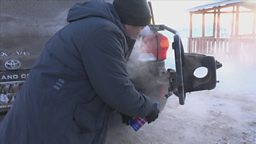
Cold like I’ve never experienced before
The continental winter climate hit us hard and we had many challenges in store. It was so dry, any moisture in the air had frozen into beautiful sparkles that floated on the air. And each inhale of cold air sent prickles up my nose as the moisture froze.
Blow torches were used in the early mornings to release car doors frozen solid overnight
We were living in a traditional ger camp, nomadic tents, similar to a yurt, for the duration of our trip. The toilet was a long drop 300 metres away, basically a freezing metal shed. The loo seat had a fluffy cover in an effort to claw back some comfort in what was an often unpleasant and windy experience! The only saving grace was that everything was frozen! Blow torches were used in the early mornings to release car doors frozen solid overnight and moving from warmth to the freezing cold often triggered a nosebleed.
And this was all before sunrise! We would then sit for over 10 hours at a time, watching and waiting for the cats. Armed with walkie talkies, the camera team were each curled into tiny 1.5 metre cubed wooden boxes with myself installed further away in a separate white tent spotting with binoculars.
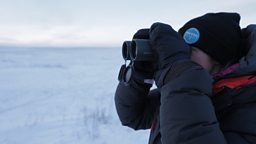
To keep us warm required several layers of down, including down salopettes and a sleeping bag with hand warmers shoved inside. Our get-up felt like we were walking in a mobile duvet and looked like we wanted to be the Michelin man. Each day we were handed a steaming bowl of Mongolian cuisine, that we would try in vain to keep from freezing with hand warmers. We became quite accustomed to a cold lunch, often eating it at 10am before it totally froze, surviving on snacks for the remaining eight hours! The cats would only emerge if the sun was out.
Warming our feet up would be the task at the end of each day.
But the steppe could be hit suddenly by fast and bitter winds that would whip up the dry snow and dust into our hides, putting pay to any animal emerging. The decision on whether to hold out for the weather to pass or call it a day was always an agonising one. Warming our feet up would be the task at the end of each day. One particularly frigid day my feet got so cold, it felt like I was walking on stumps – I had lost all feeling in my feet. Technology also struggled. We took an inordinate number of camera batteries for fear of them dying of the cold at that critical behavioural moment. And comms were tough to maintain. Walkie talkies would die, on several occasions just at the wrong time. In those moments you could cry with frustration.
But as the weeks went on and we spent more time with the cats, it was remarkable to see just how they could live in such a hostile environment. Through the many trials and tribulations, we fell in love with these little characters and were given a privileged view of the winter life of the Pallas’s cat. And as it turns out, sometimes even the fluffiest cat in the world can be irritated by the cold. No wonder it seems grumpy!
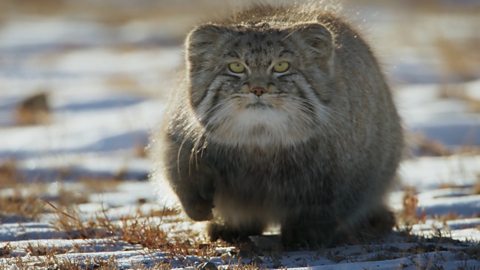
"The grumpiest cat in the world"
On the Great Steppe of Central Asia, a Pallas's cat tries to catch voles and gerbils.
